The drug and biotech industry has done well this year, driven by increased mergers and acquisitions (M&A), the launch of promising new medicines and pipeline successes. Obesity drugs of Novo Nordisk and Eli Lilly LLY have witnessed tremendous success, which has played a key role in the industry’s outperformance. Large drugmakers have several robust revenue streams and are mostly profitable companies, which makes them safe havens for investments. Innovation is key to the growth of the industry. Innovation in the industry is at its peak, with spaces like weight loss/obesity, inflammation and Alzheimer’s disease attracting investor interest. M&A activity also remains strong.
However, regular pipeline setbacks, slow ramp-up of newer drugs, supply chain disruptions, uncertainty about the impact of Medicare drug price negotiations, Federal Trade Commission’s (FTC) scrutiny of M&A deals and macroeconomic uncertainty ahead of the U.S. presidential elections are some of the headwinds for the sector. Despite these headwinds, there has been a surge in investments in drug/biotech stocks this year, marking a turnaround from last year.
Among the large drugmakers, Eli Lilly, AstraZeneca AZN, Pfizer PFE, Sanofi SNY and Bayer BAYRY are worth retaining in one’s portfolio.
Industry Description
The Zacks Large Cap Pharmaceuticals industry comprises some of the largest global companies that developmulti-million dollar drugs for a broad range of therapeutic areas like neuroscience, cardiovascular and metabolism, rare diseases, immunology and oncology. Some of these companies also make vaccines, animal health products, medical devices and consumer-related healthcare products.These players invest millions of dollars in their product pipelines and line extensions of their already-marketed drugs. Continuous innovation is a defining characteristic of pharma companies, and these large drugmakers are constantly investing in drug development and discovery of new medicines. Regular mergers and acquisitions and collaboration deals are other key features of large drug companies.
What’s Shaping the Future of the Large-Cap Pharma Industry?
Innovation and Pipeline Success: For big drugmakers, an innovative pipeline is a competitive necessity and key to top-line growth. Pharma companies are constantly striving to ramp up innovation and spend a significantly high portion of their revenues on R&D. Successful innovation and product line extensions in important therapeutic areas, and strong clinical study results may act as important catalysts for these stocks.
Aggressive M&A & Collaboration Activity: The sector is characterized by aggressive M&A activity. Given that it takes several years and millions ofdollars to develop new therapeutics from scratch, large pharmaceutical companies, sitting on huge piles of cash, regularly buy innovative small/mid-cap biotech companies to build out their pipelines. Also, sloppy sales of mature drugs, dwindling in-house pipelines, government scrutiny of drug prices and the emergence of big tech firms like Apple and Google in the healthcare industry whet the M&A appetite of large drugmakers.Also, collaborations and partnerships with smaller companies are in full swing.Fast-growing and lucrative markets such as oncology, rare disease and cell and gene therapy are likely to remain focus areas for M&A activities. Of late, areas like obesity and inflammatory bowel disease are attracting buyout interest. There has been a slew of M&A announcements in 2024. Some of the larger ones are Eli Lilly’s buyout of Morphic, Vertex’s buyout of Alpine Immune Sciences and Novo Nordisk’s offer to buy Catalent.
Pipeline Setbacks & Other Headwinds: The failure of key pipeline candidates in pivotal studies and regulatory and pipeline delays can be setbacks for large drug companies and significantly hurt their share prices. Other headwinds for the industry include pricing and competitive pressure, generic competition for blockbuster treatments, the slowdown in sales of some of the most high-profile older drugs, Medicare drug price negotiations and increasing FTC scrutiny of M&A deals.
Macroeconomic Uncertainty: Escalating geopolitical tensions (the Russia-Ukraine and Gaza-Israel conflicts) and their impact on global economic growth and macroeconomic uncertainty ahead of the U.S. presidential elections have increased broader economic woes
The recent dockworkers’ strike at U.S. ports and its potential adverse impact on global supply chains is also a near-term concern.
Zacks Industry Rank Indicates a Bright Outlook
The Zacks Large Cap Pharmaceuticals industryis a 12-stock group within the broader Medical sector. The group’s Zacks Industry Rank is basically the average of the Zacks Rank of all the member stocks.
The Zacks Large Cap Pharmaceuticals industry currently carries a Zacks Industry Rank #47, which places it in the top 19% of 250 Zacks industries. Our research shows that the top 50% of the Zacks-ranked industries outperform the bottom 50% by a factor of more than 2 to 1.
Before we present a few large drug stocks that are well-positioned to outperform the market based on a strong earnings outlook, let’s take a look at the industry’s performance and its current valuation.
Industry Versus S&P 500 & Sector
The industry has outperformed the Zacks Medical Sector but slightly underperformed the S&P 500 so far this year.
Stocks in this industry have collectively risen 18.6% year to date compared with the Zacks S&P 500 composite’s increase of 20.7% and the Zacks Medical Sector’s increase of 6.4% in the said time frame.
YTD Price Performance
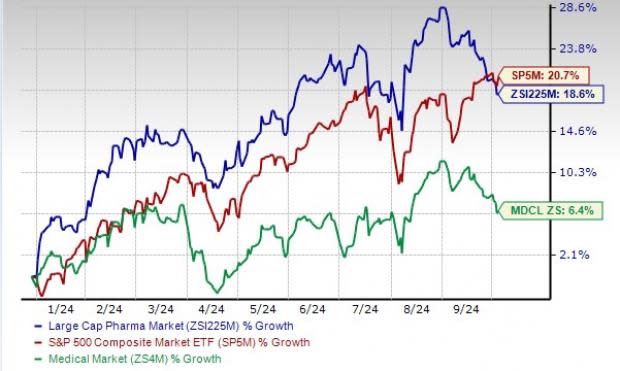
Industry’s Current Valuation
Based on the forward 12-month price-to-earnings (P/E), a commonly used multiple for valuing large pharma companies, the industry is currently trading at 18.82X compared with the S&P 500’s 21.71X and the Zacks Medical Sector’s 22.59X.
Over the last five years, the industry has traded as high as 20.69X, as low as 13.31X and at a median of 15.18X, as the chart below shows.
Forward 12-Month Price-to-Earnings (P/E) Ratio
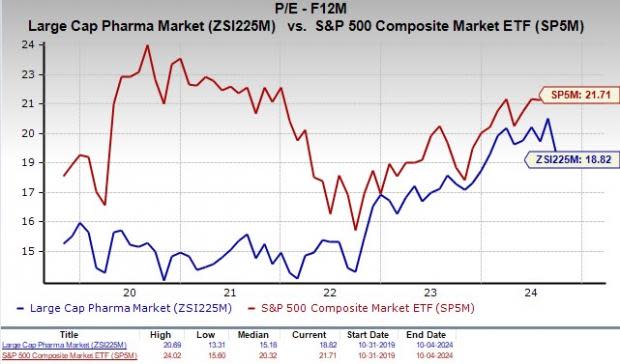

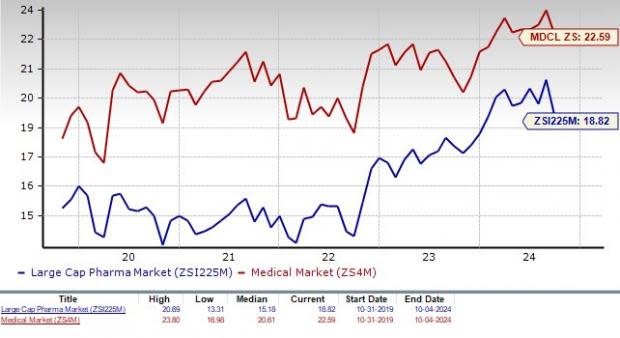

5 Large Drugmakers to Watch
Eli Lilly: It has consistently reported strong revenues and profits and dealt well with expiring patents and increasing competition. The stupendous success of GLP-1 drugs, Mounjaro (diabetes) and Zepbound (obesity), has made it the largest drugmaker with a market cap of more than $840 billion. Mounjaro and Zepbound have become key top-line drivers despite a short time on the market. Both include the same compound tirzepatide, a dual GIP and GLP-1 receptor agonist (GIP/GLP-1 RA), a category gaining tremendous popularity. Tirzepatide is also being developed for other indications, approvals for which can further boost sales.
In the past couple of years, Lilly has also received approvals for several new drugs like Kisunla, Omvoh and Jaypirca and witnessed pipeline and regulatory success. Its new drugs have been contributing significantly to its top-line growth in 2024. Incremental contribution for new drugs, rapid pipeline progress in areas like obesity, diabetes and Alzheimer’s and regular M&A activity are key reasons to invest in the stock.
Eli Lilly has a Zacks Rank #1 (Strong Buy) currently. You can see the complete list of today’s Zacks #1 Rank stocks here
The Zacks Consensus Estimate for Lilly’s 2024 EPS has risen from $13.79 to $16.49 per share over the past 60 days. The stock has risen 52.2% year to date.
Price and Consensus: LLY
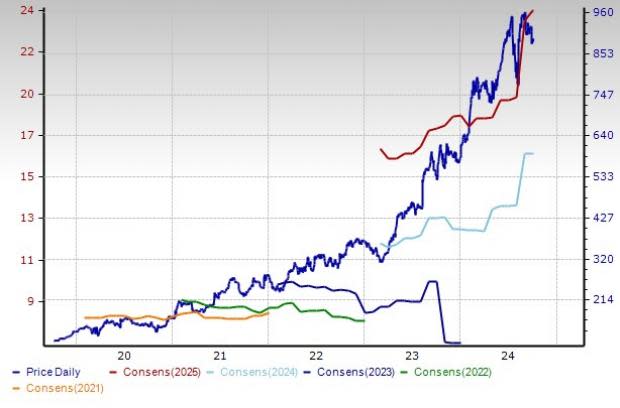

AstraZeneca: It boasts a diversified geographical footprint as well as a product portfolio with several blockbuster medicines. AstraZeneca now has 12 blockbuster medicines in its portfolio, with sales exceeding $1 billion, including Tagrisso, Fasenra, Farxiga, Imfinzi, Lynparza, Soliris and Ultomiris. These drugs are driving the company’s top line with AstraZeneca launching them in more markets and an increased number of indications.
AstraZeneca has been making significant progress with its pipeline in areas like oncology, cardiovascular health, immunology and rare diseases. This year, it has acquired small biotechs like Gracell, Fusion Pharmaceuticals and Amolyt to strengthen its pipeline.
Backed by its new products and pipeline drugs, AstraZeneca believes it can post industry-leading top-line growth in the 2025-2030 period. AstraZeneca expects to generate $80 billion in total revenues by 2030. By the said time frame, AstraZeneca plans to launch 20 new medicines. It believes that many of these new medicines will have the potential to generate more than $5 billion in peak-year revenues. The company is also on target toachieve a mid-30s percentage core operating margin by 2026.
AstraZeneca has a Zacks Rank #2 (Buy) currently. The Zacks Consensus Estimate for AstraZeneca’s 2024 EPS has risen from $4.04 per share to $4.08 per shareover the past 60 days. The stock has risen 15.0% so far this year.
Price and Consensus: AZN
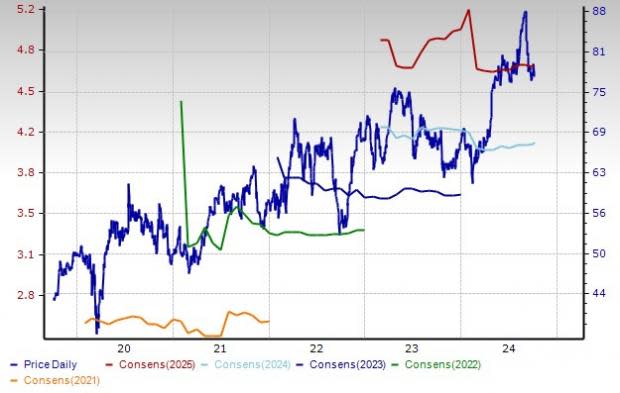

Bayer: The company’s key drugs, Nubeqa for cancer and Kerendia for the treatment of patients with chronic kidney disease associated with type II diabetes, are fueling growth in its Pharmaceuticals division. The company is also working to expand the labels of Nubeqa and Kerendia, which, if successful, can further drive growth. Bayer also plans to launch two new drugs, elinzanetant and acoramidis, in 2025.
Sales in the Crop Science division declined significantly in 2023 due to lower volumes and prices for glyphosate-based products. However, sales in the segment improved slightly in the second quarter of 2024 amid headwinds in a challenging agricultural market environment. Consumer Health returned to growth.
This Zacks #2 Ranked stock has declined 10.9% so far this year. Estimates for its 2024 earnings per share have increased from $1.35 to $1.38 over the past 60 days.
Price and Consensus: BAYRY
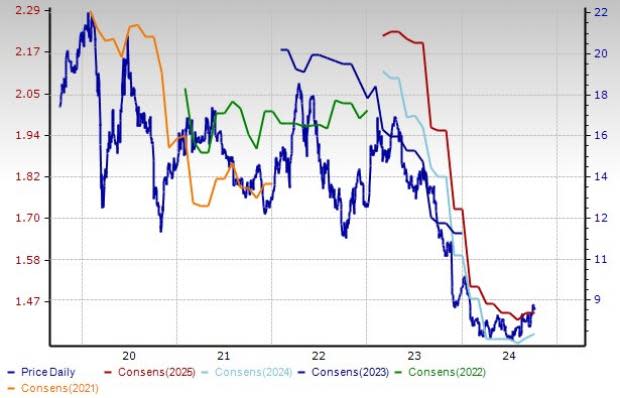

Sanofi: Its immunology drug Dupixent has become a key top-line driver on strong demand trends.Dupixent is now annualizing at close to €11.0 billion in sales after almost eight years on the market. Sanofi expects Dupixent to achieve more than €13 billion in sales in 2024 and a low double-digit CAGR till 2030. Sanofi possesses one of the world’s leading vaccine operations, with total annual sales of more than €5 billion in the past five years. Sanofi expects annual net sales to be more than €10 billion from its Vaccines unit by 2030, backed by its innovation efforts.
It has launched several new drugs in the past couple of years and accelerated its mid- and late-stage pipeline this year. It has also been active on the M&A front.
In July, Sanofi improved its earnings growth expectations for 2024 from a decline in the low single-digit range to stable on a constant currency rate basis. The increase in guidance was based on a strong performance in the first half and an optimistic outlook for the second half of the year.
Sanofi has a Zacks Rank #3.
Estimates for its 2024 earnings per share have risen from $4.21 per share to $4.26 per share over the past 60 days. The stock has surged 11.5% year to date.
Price and Consensus: SNY
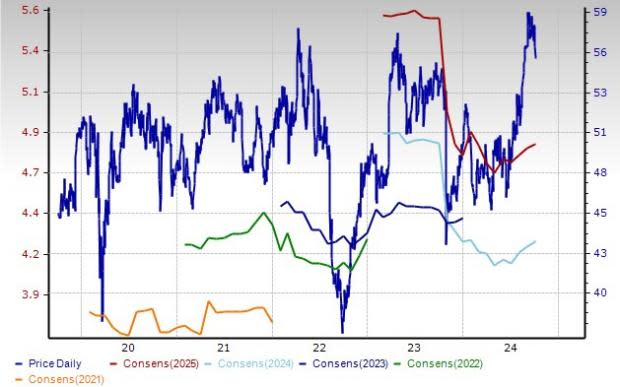

Pfizer: It is one of the largest and most successful drugmakers in the field of oncology. Its position in oncology was strengthened with the addition of Seagen in December last year. After a couple of tough years, it seems that Pfizer’s worst slowdown is over now, and the company is gradually making a comeback. Though Pfizer’s COVID revenues are declining, its non-COVID drugs and potential contributions from new and newly acquired products have started to drive growth.
Pfizer’s non-COVID operational revenues improved in the first half of 2024, driven by its key in-line products like Prevnar, Vyndaqel and Eliquis, new launches like Abrysvo, Velsipity, Penbraya, newly acquired products like Nurtec as well as those acquired from Seagen (December 2023). The trend is expected to continue in the second half.
Pfizer’s new products/late-stage pipeline candidates, coupled with newly acquired products, including those acquired from Seagen, position it strongly for operational growth in 2025 and beyond. Huge profits from its COVID products strengthened its cash position. The funds are being used to make acquisitions, increase dividends, buy back shares and reduce debt.
Pfizer is a #3 Ranked stock. The Zacks Consensus Estimate for 2024 EPS has risen from $2.59 to $2.62 per share over the past 60 days. The stock has declined 0.7% so far this year.
Price and Consensus: PFE
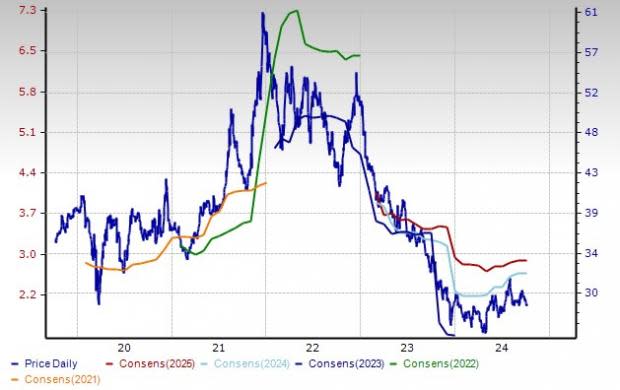

Want the latest recommendations from Zacks Investment Research? Today, you can download 7 Best Stocks for the Next 30 Days. Click to get this free report
Eli Lilly and Company (LLY) : Free Stock Analysis Report
Sanofi (SNY) : Free Stock Analysis Report
AstraZeneca PLC (AZN) : Free Stock Analysis Report
Pfizer Inc. (PFE) : Free Stock Analysis Report
Bayer Aktiengesellschaft (BAYRY) : Free Stock Analysis Report
Source Agencies
